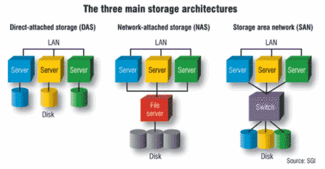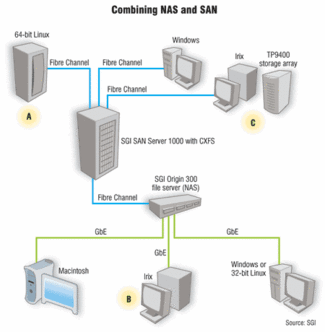n media environments, there’s a clear trend away from direct-attached storage to network storage, which provides a number of advantages for collaborative projects.
When it comes to the storage infrastructure underpinning your digital content operations, you have three choices: direct-attached storage (DAS), network-attached storage (NAS), or storage area networks (SANs). And in studio environments, the trend is clearly away from DAS toward networked storage architectures such as NAS or SAN (see Figure 1).
Jim Farney, senior marketing manager for media industries at SGI (and the owner of a post-production facility—Pacific Video Resources, in San Francisco—for more than 20 years before he joined SGI) says that most large studios have already begun the transition toward networked storage, while smaller studios are still primarily using DAS. But he says that all sizes of studios can benefit from networked storage.
“Direct-attached storage [where disk drives are directly attached to workstations or servers] poses problems in media environments because everything is a collaborative process, with many people having to manipulate content before it goes out the door,” says Farney. “If you do it with direct-attached storage you have to move, or copy, data over and over between graphics professionals. And as you move to higher resolutions and larger files, that becomes an onerous and time-consuming task. There’s a growing realization that professionals in collaborative environments have to move to some form of networked storage, whether it’s NAS, SAN, or a combination of them.”
In addition to the content-sharing advantages of networked storage, studios may need the increased bandwidth of NAS (which attaches to Gigabit—1Gbps—Ethernet networks) or SANs (which are based on high-speed 2Gbps Fibre Channel networks).
“In the broadcast media space there’s a big trend toward networked storage because media facilities are moving huge amounts of content, which requires very high bandwidth,” says Jay Krone, director of CLARiiON platforms marketing at EMC. “A 90-minute feature film in uncompressed HDTV format could require more than a terabyte of storage capacity.” (EMC’s CLARiiON storage systems were used by editors on a variety of films, including The Perfect Storm, Gladiator, Mission: Impossible 2, American Beauty, and X-Men.)
The trend toward networked storage is also being fueled by analog-to-digital conversion, which drives the need for much higher bandwidth and storage capacities.
Network-attached storage
For digital content professionals, the primary advantages of NAS are low cost (versus SANs) and the ability to share files (versus DAS). Virtually all NAS servers support CIFS (the network protocol for Windows platforms) and NFS (for Unix platforms), and some NAS servers also support protocols for file sharing in Apple and other environments.
Although DAS is fine for professionals who do not need collaborative file sharing, or who spend most of their time working on still creation, for instance, NAS provides advantages in collaborative environments where high-speed file sharing is necessary.
Whether to migrate to NAS or SAN depends largely on your budget and bandwidth requirements. “NAS works great if you’re doing, for example, standard-definition digital video editing with four or five video streams at up to 50MBps per client,” says Gerry Johnson, senior product manager at Ciprico, a storage vendor that specializes in digital media applications. “But NAS may not provide enough performance in film editing environments that require throughput of, say, 200MBps and 2K-by-1K film resolution playback in uncompressed format.”
NAS file servers are typically attached to Ethernet networks. Gigabit Ethernet is rated at a maximum of 125MBps, although in reality users may achieve only 60MBps to 70MBps due to network overhead. According to a variety of storage vendors that focus on media applications, Gigabit Ethernet is a good choice when many clients must access files but none have sustained requirements for large amounts of data, as in a render farm.
Network-attached storage (NAS) file servers from Network Appliance were used by Weta Digital Effects’ graphics artists to create many of the special effects in the Lord of the Rings trilogy. The Lord of the Rings: The Return of the King. Photo: New Line Productions copyright 2003.
Gigabit Ethernet networks have boosted the throughput you can get with NAS servers and have enabled high-speed file sharing in media applications, but the real breakthrough will come with 10Gbps Ethernet, which is just starting to be used in IT environments. “Although expensive, 10Gbps Ethernet will enable more than adequate performance in all video environments, including high-definition video,” says Ciprico’s Johnson.
Another way to boost performance of NAS systems is to add TCP/IP offload engine (TOE) cards, which are available from vendors such as Alacritech and Intel. TOEs accelerate NAS performance by offloading TCP/IP protocol processing from the host processor.
Is NAS ready for big-budget film and TV production? To take just a couple of examples, Weta Digital Effects (in New Zealand) used NAS file servers from Network Appliance as primary storage for the special effects in New Line Cinema’s Lord of the Rings trilogy.
Specifically, Weta used Network Appliance’s F840 NAS systems, which Network Appliance refers to as “filers,” for special effects and other content creation jobs involving terabytes of storage capacity, high-speed image manipulation (with single images that often exceeded 12MB), and more than 150 graphics artists. (Network Appliance NAS filers are also used to store the content at www.lordoftherings.com.)
Reel FX Creative Studios, a 3D animation and visual effects studio in Dallas, relied primarily on NAS file servers in a variety of film and TV projects, including the NBC movie Saving Jessica Lynch, heavily animated TV commercials for Hasbro, and a direct-to-DVD G.I. Joe film. Reel FX uses SGI’s InfiniteStorage NAS 2000 systems for animation, effects, video editing, and post-production work in an environment with a variety of platforms, including Windows, Macintosh, Linux, and Irix—all of which can access the same files simultaneously without file copying.
In the end, however, it may be the low cost of NAS that is most appealing for studios with limited budgets. For example, Huge Systems, a storage vendor that specializes in the video and rich media markets, sells a 1TB NAS server for $10,600; a 3TB version is priced at $23,900. The company targets digital video and standard-definition applications with its NAS servers, according to Mike Anderson, chief technology officer at the company. (Huge Systems will be demonstrating its NAS systems and disk arrays at next month’s NAB show.)
Storage area networks
If NAS doesn’t provide enough performance, you may need to consider a SAN, most of which are based on Fibre Channel technology. “If you have hundreds of seats in a collaborative environment with high-definition editing, then a SAN is the only way to go,” says Ciprico’s Johnson.
For studio environments, the primary advantages of SANs are consolidated storage, centralized management, and a dedicated high-speed network. 1Gbps Fibre Channel is rated at a maximum transfer rate of 100MBps, although actual speeds may be more in the 75MBps to 80MBps range. 2Gbps Fibre Channel is rated at a maximum 200MBps, although speeds of 150MBps to 160MBps are more likely.
The downside to SANs is that they’re expensive. The cost of the SAN hardware and software could easily eclipse the total cost of your workstations, graphics cards, and software. Pricing varies widely, but Fibre Channel host bus adapters (which are required for all servers and workstations attached to the SAN) can cost around $1,000 per platform. And Fibre Channel switches are considerably more expensive than Ethernet switches—more than $600 per port. In addition, Fibre Channel SANs require new cabling, specialized (and expensive) expertise and, possibly, expensive SAN management software.
However, SANs do provide the ultimate in storage performance, and when coupled with shared file systems, they provide file sharing (including concurrent file access) for collaborative work environments.
Shared file systems are available from vendors such as ADIC (StorNext File System), IBM (TotalStorage SAN File System), and SGI (InfiniteStorage CXFS). In addition, bundled Fibre Channel SANs with shared file systems are available from a few other vendors that specialize in the video/graphics markets, such as Avid and Pinnacle Systems.
Some shared file systems provide content sharing among diverse platforms, such as Windows, Unix, and Macintosh—a platform mix that is common in many studios. For example, SGI’s CXFS file system supports Windows, AIX, Linux, Irix, Solaris, and Macintosh platforms.
The NAS-versus-SAN decision also relates to the type of content you’re storing. “NAS is good enough for 8-bit standard-definition material, but if you need to share high-definition content then a SAN may be the only way to go,” says Huge Systems’ Anderson.
Although SANs provide high bandwidth and content sharing, some studios install a SAN for simpler reasons—at least initially. For example, Tippett Studio deployed a SAN primarily to solve backup problems, according to Christian Rice, director of technology at Tippett (see sidebar, “Tippett banks on a SAN,” p. 37).
Mix ‘n match
The various types of storage architectures (DAS, NAS, and SAN) are not mutually exclusive. For example, you can mix NAS and SAN according to bandwidth and budget requirements (see Figure 2). “Professionals who need really high bandwidth, such as render farms, can use a Fibre Channel SAN while everybody else uses less-expensive NAS on existing Ethernet networks,” says SGI’s Farney. “NAS-SAN convergence will be a big trend in studio environments with a mix of bandwidth requirements. You get the file-sharing benefits of NAS with the higher bandwidth of a SAN.”
Figure 2: A hybrid storage architecture combines direct-attached storage, network-attached storage (NAS) over Gigabit Ethernet (GbE), and a storage area network (SAN) over Fibre Channel. The diagram shows a configuration with a shared file system, which allows users to simultaneously access content.
Tippett banks on a SAN
Tippett Studio, a visual effects facility in northern California, faced huge amounts of data as it was working on films such as The Matrix: Revolutions, Stepford Wives, Hellboy, and Starship Troopers 2. To cope with the rapidly increasing storage capacities required for those projects, the studio installed a storage area network (SAN) in mid-2003.
“The main reason we went to a SAN was so that we could back up all of our data without impinging on server bandwidth,” says Christian Rice, director of technology at Tippett. “Our disk capacity is doubling every year or so, and sometimes we generate more than 200GB of new data every day.”
At the heart of the SAN are two 16-port, 2Gbps Fibre Channel switches from Brocade, which attach to the studio’s servers and storage arrays (most of which are from SGI), and backup systems. The SAN has hundreds of client workstations (mostly Linux and Windows), and a total storage capacity of 16TB, which is expected to increase to 19TB in a month or two.
Rice says that in addition to enabling better backup operations (without negatively impacting overall performance), the SAN provides centralized storage and content management, as well as data sharing via SGI’s CXFS shared file system. “All of our systems can access data simultaneously,” he says. The SAN also allowed Tippett to balance workloads across the storage network to optimize performance and “to export data to clients much better and more dynamically,” according to Rice.
Prior to migrating to a SAN architecture, Tippett’s storage infrastructure was based primarily on direct-attached storage with some network-attached storage (NAS) systems.



